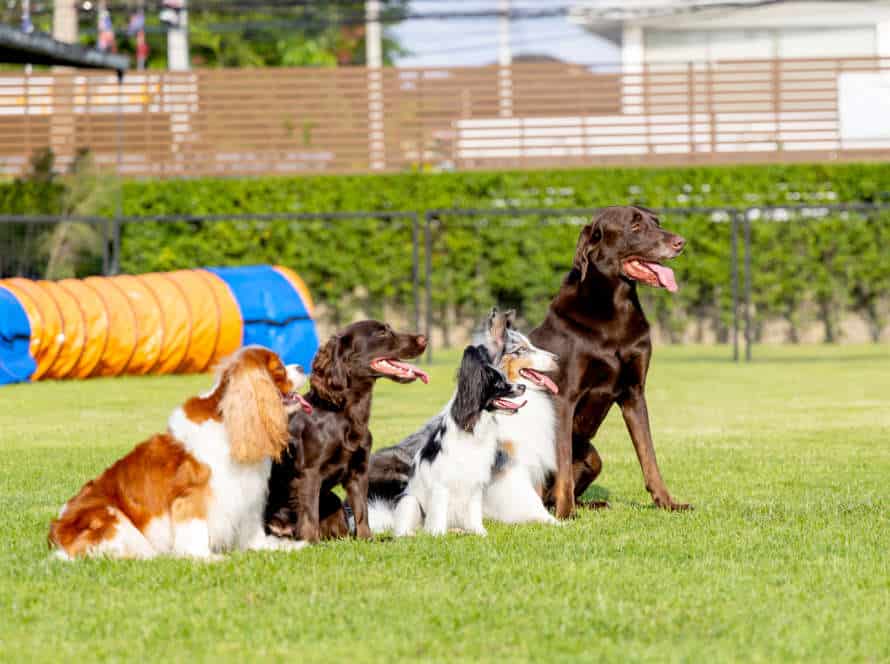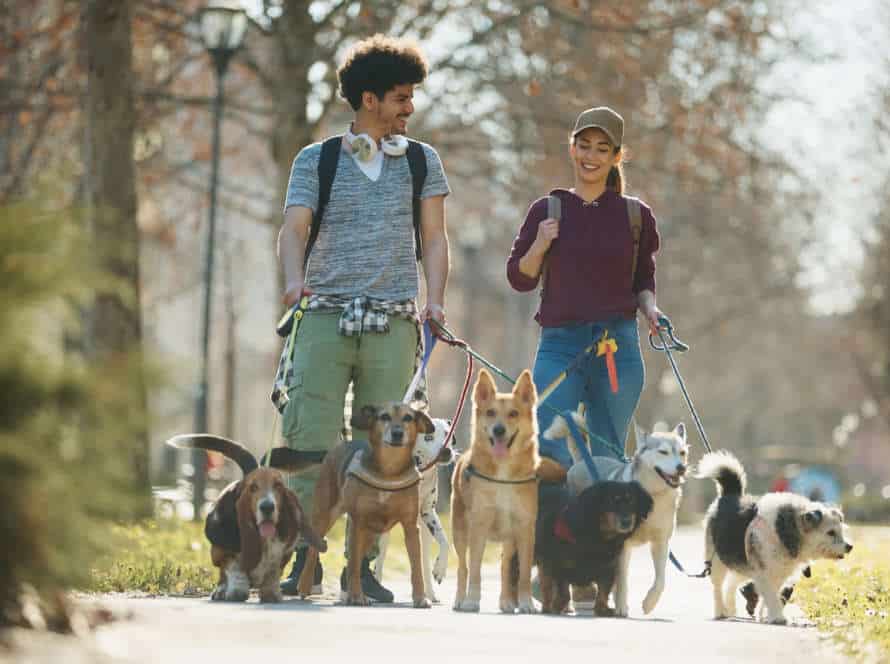Mutts vs. Purebreds: Training Differences to Consider
Mutts and purebreds can both make great pets. But there are a few training differences.
Purebreds are bred for certain traits, making them easier to train for specific tasks. Their temperament and energy level is more predictable.
On the other hand, mutts have a diverse genetic makeup. They are often seen as more adaptable, curious and open to learning.
It’s important to remember that both can benefit from socialization and obedience training. This helps them become happy, healthy and well-behaved.
Nature vs. Nurture
When picking between a purebred or mutt, there are many things to consider. One of the major factors is how they respond to training. Research reveals both genetics and environment can factor in training, so it’s important to understand the contrast between the two. Let’s dive into the nature versus nurture debate when it comes to training your pup!
The role of genetics in dog behavior and trainability
Genetics are essential when it comes to a dog’s behavior and their capacity to be trained. Although all dogs can be taught through the right methods, purebred and crossbreed dogs show different natural inclinations which can have an effect on their training.
Purebreds have been bred to have specific qualities, such as a strong hunting drive or a strong guard instinct, which can make them easier or more complicated to train in particular scenarios. For instance, a Border Collie’s natural instinct for herding may make them more responsive to obedience training, while a Chihuahua’s independent nature may make them more difficult to teach.
On the other hand, crossbreeds may have a more varied genetic heritage, making it hard to guess their conduct or trainability. Still, with patience and consistency, mixed breed dogs can learn just as well as purebreds, if not better.
When it comes to training dogs, it’s key to take both nature and nurture into account to get the best possible results. Knowing a dog’s genetic history can help inform training techniques and expectations. Furthermore, it’s vital to give a supportive and nurturing environment that promotes positive behavior.
The effect of environment and socialization on dog behavior and trainability
The behavior and trainability of dogs are affected by both nature and nurture. Genetics, breed, environment, and socialization experiences all play a role. Purebred dogs may have certain predispositions, but this does not guarantee their behavior or learning abilities.
Environment: Stimulating, supportive, and consistent environments support better-adjusted and trainable dogs. Neglectful or abusive environments can lead to fear, aggression, or hyperactivity.
Socialization: Early socialization with people, other dogs, and pets can help dogs become more social, better-behaved, and less anxious. Lack of socialization may result in timid or aggressive behavior.
Breed: Breed characteristics can provide a guide to a dog’s behavior and trainability, but not their individual personality or learning abilities. Mutts may exhibit a wide range of traits and behaviors depending on their genetics and upbringing.
Training: Consistent and reward-based training can help dogs learn commands, tricks, and behavior modification techniques, regardless of their breed or background. A combination of positive reinforcement, appropriate socialization, and a nurturing environment can help dogs become happy, healthy, and well-behaved companions.
Training Differences between Mutts and Purebreds
Training a pup can be a fulfilling experience. But, the difficulty of training and the technique used can vary depending on the breed of dog you get. Mutts versus purebreds have some differences when it comes to training. Before getting a pup, consider these differences in potty training and basic commands. Let’s have a peek and see what they are.
Understanding breed-specific traits in purebreds
Purebreds are bred for particular traits, such as size, temperament, and coat. It’s essential for dog owners to know these breed-specific traits when training their pup. Mutts or mixed-breed dogs are usually a result of chance. They have fewer breed-specific traits, making them more flexible to train.
Purebreds have special training needs based on their breed. For example, an Aussie Shepherd needs lots of exercise and mental stimulation to stop bad behavior. Whereas, a Doberman needs strong, consistent training to become a faithful, protective companion.
When selecting a purebred, it’s important to research and comprehend its breed-specific traits. This will help set achievable training expectations and provide the proper care and training required for the dog’s wellbeing.
Training challenges related to breed-specific traits in purebreds
Training purebred dogs can be challenging due to their breed-specific traits.
For example, German Shepherds are natural problem solvers and need lots of mental stimulation. Bichon Frises, on the other hand, have high energy and can get easily distracted.
So, it’s important to research and understand your breed’s traits and adjust your training accordingly.
Patience and consistency are key, as it may take longer to train a purebred than a mixed-breed dog.
Positive reinforcement works best – give treats and praise to encourage good behavior.
Ensure training sessions are fun and engaging.
These tips will help you successfully train your purebred dog despite its breed-specific traits.
Benefits of mixed-breed dogs in terms of trainability and behavior
Mutts, or mixed-breed dogs, are unique. They possess traits from several breeds, making them easier to train and well-behaved. Here’s why they’re great:
- Trainability – Mutts are intelligent and versatile. They love to please their owners, so they pay attention during training.
- Health and Behavior – Mutts can inherit healthy genes, reducing the chance of inherited diseases. They also have a balanced temperament, making them great for new environments.
- Lower Maintenance – Mixed-breed dogs need minimal grooming and exercise, compared to some purebreds.
So, if you want a well-behaved and trainable companion, mixed-breed dogs are your best bet!
Best Training Techniques for Mixed-breed Dogs
Questions about pet dogs often come up: What breed is best to get? How can you train them? Mixed-breeds, or ‘mutts’, are popular. For these unusual animals, there are special training techniques to be aware of. Let’s research the best training methods for mixed-breed dogs.
Positive reinforcement training
Positive reinforcement training is a powerful way to train mixed-breed dogs. This works by rewarding the good behavior, instead of punishing bad behavior. Here are some tips:
- Use small, healthy treats as a reward.
- Be consistent and use a clicker to mark good behavior.
- Start with simple commands and progress to more complex ones.
- Train 10-15 min daily.
- Be patient and make it a positive experience for both.
Socialization techniques for mixed breeds
Socializing mixed-breeds takes a different approach than purebreds. They have diverse genetics, and their behavior and temperament vary from pup to pup. Here are tips to help socialize them:
- Reward good behavior and socialization with treats, toys and love.
- Start early and keep exposing them to new people, animals, and places.
- Set clear rules and stick to them.
- Stimulate their minds with games, puzzles, and exercises.
Patience, consistency and positive reinforcement are essential when it comes to socializing mixed-breeds.
Strategies for dealing with behavior issues in mixed-breed dogs
Training mixed-breed dogs to behave requires a blend of different strategies, as they can have different temperaments and needs compared to purebreds. Here are some helpful tips:
- Positive reinforcement – use treats, praise, and attention to reward good behavior and socialize.
- Consistency – create a routine, communicate clear rules, and stick to them.
- Exercise – regular activity is essential for a healthy and happy pup, and can calm destructive behaviors.
- Socialization – help your dog become comfortable with different people and animals.
- Obedience training – teach basic commands like come, sit, and stay.
Taking the time to understand your dog and provide consistent, positive training can help tackle any behavior issues in mixed-breed dogs.
Best Training Techniques for Purebred Dogs
Purebred dogs have special genetic traits that make them distinct from mutts. This can mean they need special training techniques too. So, let’s look at what works best for purebreds!
Positive reinforcement, tools, and toys are all great options. Training your pup has never been easier!
Breed-specific training techniques
Breed-specific training is essential for purebred dogs. Every dog has a special temperament, so training should be tailored to each one. For example, herding dogs like the Border Collie and Australian Shepherd need physical and mental stimulation. Meanwhile, retrievers such as Golden Retrievers and Labradors love interactive training with treats and toys.
Socialization is also critical for purebreds. This teaches them to interact with others, which is especially important for breeds like the Pit Bull and Rottweiler. Socialization can reduce anxiety and create positive experiences, improving their overall behavior.
Keep these unique characteristics in mind when training purebreds. Breed-specific training and socialization can be very helpful in transforming them into well-behaved pets.
Pro tip: Obedience classes can provide professional guidance and socialization opportunities for your purebred dog.
The importance of early training and socialization
Training and socializing pups is essential, no matter their breed or background. Those who get proper training and socialization develop amazing relationships with humans and other dogs. But those who don’t, may have issues later.
Here are the advantages of early training and socialization:
- Boosts confidence: Training gives puppies new experiences and helps them to trust themselves and their environment.
- Stops problem behaviour: Pups that get early training and socialization are less likely to act out with aggression, barking and chewing.
- Grows social skills: Socializing teaches puppies how to interact with humans and other dogs, improving their ability to talk and stay away from fights.
- Strengthens the dog-human relationship: Early training and socialization help puppies form a strong bond with their owners, leading to joy for both pup and person for the rest of their lives.
Working with professional dog trainers and breed-specific experts
For successful training of purebred dogs, it is important to work with professional dog trainers and breed-specific experts. They can offer personalized strategies and solutions for a dog’s breed, personality, and how it learns. Breed-specific experts can also provide useful details about breed-specific behaviors and inclinations.
When it comes to training purebreds compared to mutts, there are some distinctions. Purebreds may have more foreseeable behaviors and dispositions but they can also be more susceptible to certain health problems, and may need special care and training. Mutts, on the other hand, may bring unique difficulties due to their various genetic backgrounds.
In the end, collaborating with professional trainers and experts can give you the direction and assistance you need to train your purebred dog. This will guarantee a content and healthy relationship for years to come.
Conclusion: Choosing the Right Training Approach for Your Dog
The responsibility of selecting a dog training approach is yours and your pup’s. Purebreds or mixed breeds can succeed with either option, but it depends on your lifestyle and budget. Here are some things to consider when making this decision: lifestyle, budget, and individual pet.
Understanding your dog’s breed-specific traits and behaviors
It’s key to know your pup’s breed traits and behavior. It doesn’t matter if they are mongrels or purebreds. Knowing the specific characteristics can help you pick the proper training.
For example, Border Collies, a herding breed, are real active, smart, and independent. They need lots of exercise and mental stimulation to stop bad behavior. Chihuahuas, a toy breed, are sensitive and temperamental. Their owners should prioritize socialization, obedience training, and positive reinforcement.
Knowing a breed’s typical actions and tendencies can guide you in picking the best training method for your pet. Adapting these qualities with a tailored training approach can ensure successful training in the long run.
Considering the benefits of mixed-breed dogs for trainability and behavior
Mixed-breed dogs are usually praised for their trainability and good behaviour. It’s thought that due to their diverse ancestry, they have a more balanced attitude and are less likely to have genetic issues leading to negative behaviour. However, one must take into account that each dog’s temperament varies, no matter its breed or mix.
When training, the most important factor is the pup’s specific personality and requirements. Different training techniques work better for different doggos, so patience and reliability in implementing your methods is key.
Whether you have a mutt or purebred, it’s recommended to socialize and train them from an early age to avoid any behavioural issues.
Pro tip: Keep training sessions short and sweet, focus on positive reinforcement and use treats for good behaviour.
Working with professional dog trainers to tailor your training approach to your dog’s individual needs.
Expert dog trainers can assist pet owners in designing a training approach that’s suited to their pup’s individual requirements. It doesn’t matter if it’s a mutt or a purebred.
Some key advantages of hiring a professional trainer include recognising the most suitable training methods for your pooch’s breed, age and personality. They can also help owners handle any behavioural issues their dog may be facing.
When selecting a training technique, it’s important to take into account the dissimilarities between training mutts and purebreds. For instance, purebreds may be more prone to particular behavioural problems because of genetic reasons. Mutts, on the other hand, may have a wide array of genetic qualities that could influence their training needs. A proficient dog trainer can aid pet owners to comprehend these differences and formulate a tailored training plan that satisfies their dog’s special needs.
Remember, dog training is an ongoing activity and engaging a professional trainer can be a beneficial investment for your dog’s health and obedience in the long run.
Frequently Asked Questions
Q: Are mutts harder to train than purebreds?
A: It depends on the individual dog’s temperament and the specific training goals. Generally, mutts can be just as trainable as purebreds.
Q: Are there certain training methods that work better for mutts versus purebreds?
A: Again, it depends on the individual dog. Some dogs may respond better to positive reinforcement, while others may need more structured training methods. It’s important to tailor the training approach to the specific dog’s needs.
Q: Do mutts have more behavioral issues than purebreds?
A: Not necessarily. Behavior issues can arise in any dog, regardless of breed. However, certain breeds may have a predisposition to certain behaviors, which can make them more challenging to train.
Q: Are purebreds easier to train because they have been selectively bred for specific traits?
A: While purebreds may have been selectively bred for certain traits, this doesn’t necessarily make them easier to train. Every dog is an individual and can have unique training needs.
Q: Do mutts require less training than purebreds?
A: No. All dogs require proper training and socialization in order to be well-behaved and obedient. The amount of training required may vary depending on the individual dog’s temperament and specific training goals.
Q: Can you train a mutt to participate in certain activities or sports?
A: Absolutely! Mutts can excel at a variety of activities and sports, from obedience and agility to search and rescue. With the right training, any dog can learn new skills and participate in fun activities.







